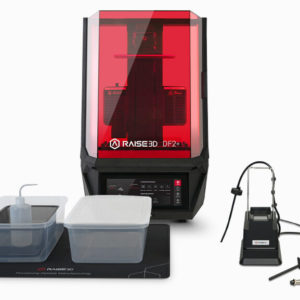
E2CF (Carbon Fiber)
The E2CF is a desktop 3D printer developed by Raise3D for carbon fiber reinforced
filaments and other composite materials.
Carbon fiber filament has low density, high strength, and it is resistant to corrosion,
static electricity and high temperature. It has potential for a wide range of applications
within industries that need considerable strength-to-weight ratio in their solutions,
such as the aviation industry and the automotive world.
The E2CF is durable, user-friendly and stable while in operation, delivering accurate
prints. It is a one-stop desktop-level manufacturing tool suitable for vast range of scenarios
- Description
- Reviews (0)
Description
the E2CF is engineered to print with fiber-reinforced materials and is optimized for carbon fiber. The E2CF meets the needs of numerous industries, including automotive, aerospace, and healthcare, who need to produce parts with a high strength-to-weight ratio and have consistent high performance during long-term operations.
Raise3D E2CF 3D printer (with dry boxes)
In addition to having the most comprehensive ecosystem in the industry, including ideaMaker slicing software and the RaiseCloud print management platform, as well as the most acclaimed features of the E2, such as IDEX technology, the flexible build plate, the resume print function, the door sensors and the power save mode, the E2CF comes with:
- Double-gear extrusion system: with twice the feeding grip force when compared to the E2, and built with hardened components that are specifically optimized for the increased wear that occurs when printing with fiber-reinforced filaments.
- High durability nozzle and feeding system: the extruders and nozzles are functionally and mechanically enhanced for long term usage, allowing for over 1000 hours of printing with Raise3D Industrial PA12 CF filament.
High durability nozzle and feeding system
- Standalone dry boxes: to ensure a stable printing process, the E2CF is equipped with two standalone sealed dry boxes developed by Raise3D to deal with the high water-absorption of nylon and fiber-reinforced filaments. These dry boxes are attached to the printer, allowing the materials to be kept in conditions of minimum humidity while printing.
Dry box
- New assisted auto-bed levelling process for fiber-reinforced filaments: equipped with a high-precision optical sensor with improved accuracy in the nozzle height calibration, for better first layer adhesion and printing performance.
New assisted auto-bed levelling process developed for fiber-reinforced material
Along with the E2CF will come the launch of the new filament Raise3D Industrial PA12 CF and its breakaway support material. The PA12 CF (Density = 1.04 g/cm3, Young’s modulus = 3.3 GPa, Tensile strength = 72 MPa, Impact strength= 12.5 kJ/m2) will allow users to produce parts that meet requirements for light weight, accurate and long-lasting high performance, with an outstanding finish that requires little or no post-processing. All these features make PA12 CF ideal for jigs and fixtures, engineering tooling and various industrial end-use parts. In addition to these materials, other high-performance filaments are in the pipeline for approval to be used with the E2CF.
Carbon-fiber part printed with breakaway support
According to Timmy Schramm, CEO of OKM3D, the distributor of 3D Printing Solutions to whom was given access to an early unit, “the E2CF makes the easy production of strong and light parts a reality, which will certainly contribute to the ongoing transformation in many industries and applications.”
Carbon-fiber parts printed on the E2CF, with an outstanding finish that requires little or no post-production
Edward Feng, Raise3D’s Global CEO said that “the global effort to manufacture more energy-efficient equipment has fuelled a high demand for high strength-to-weight ratio parts. Carbon-fiber is a great material choice for such parts, but its use in 3D printing was, until now, considered expensive. With the release of the E2CF, Raise3D fills the market gap for a desktop-level 3D printer optimized for fiber-reinforced filaments and will make carbon-fiber 3D printing affordable and simple at last. We are confident this is a relevant step in our mission to lead the promotion and implementation of Flexible Manufacturing Solutions used for low-volume or agile production, by removing another obstacle to the adoption of additive manufacturing as an alternative to traditional production.”

















Reviews
There are no reviews yet.